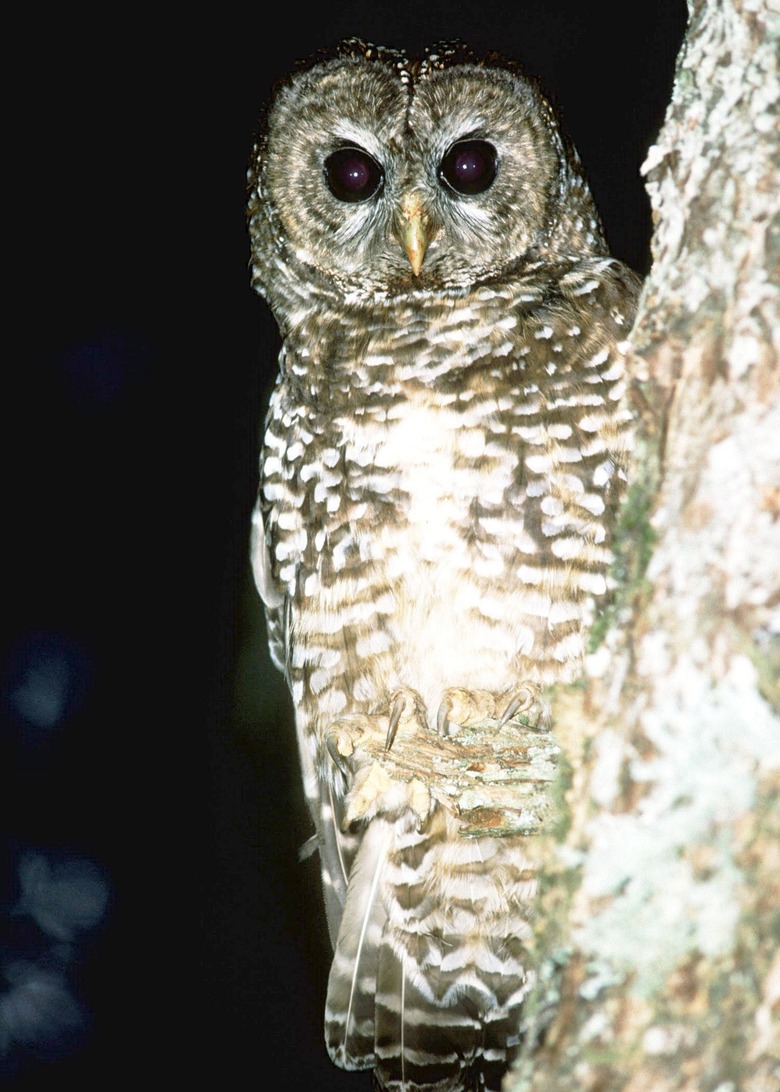Adaptations Of Deciduous Forest Owls
A large number of owls live in the deciduous forest. Common owls found in North America include the great horned owl, barred owl, spotted owl, great gray owl, barn owl, northern pygmy owl and western screech owl. Owls use unusual physical characteristics to catch prey or sense danger that other birds lack. Owls change nesting locations or eating habits during harsh weather conditions because of shortages of food.
General Owl Facts
General Owl Facts
Owls vary in size, color, nesting habits, migration and feeding. Forest owls measure between 20 and 33 inches long and have wingspans of 30 inches to 5 feet wide. All owls are nocturnal animals. The owl's prey varies depending on the species. Common live prey of owls includes rabbits, mice, rats, other birds, other small owls, squirrels, cats, fish, insects, skunks, raccoons or opossums. Owls eat prey whole and later regurgitate bones, feathers or fur. Owl pellets of regurgitated waste are used by wildlife specialists to study the local habits of the owl. Depending on the species, some owls migrate seasonally, but most do not.
Deciduous Forest
Deciduous Forest
North America contains many variations of deciduous forests. The forest's four seasons of spring, summer, autumn and winter change the environment. Hardwood trees lose leaves during the late fall and winter months, giving the forest the deciduous title. Evergreen trees, fertile soil, moss and a variety of wildflowers fill the forest along with the deciduous trees. Animals that live in deciduous forests must adapt to harsh winter conditions or migrate.
Physical Adaptations
Physical Adaptations
Owls share similar physical characteristics that provide protection from danger and enhanced hunting skills. The forest owl's head turns 270 degrees to view surroundings with keen eyesight. The owl's eyes do not move within the sockets but are located close together, giving the owl the ability to see three-dimensionally. The silken feathers provide silent flight at night when approaching prey. The owl hears frequencies that are as high as 20,000 cycles per second compared with a human's at 8,500 cycles per second, according to Norma Jean Venable, author of "Night Birds: Owls." The coloring of most forest owls provides camouflage from predators and prey. The barred owl's coloring disguises the sleeping bird during the day while other bird species are active. The owl's hook-like talons grab and carry prey with ease. When most animals have low activity, owls mate and lay eggs during the cooler months of winter and early spring. Both parents care for the chicks.
Environmental Adaptations
Environmental Adaptations
Human interference and weather prevent the owl from thriving in deciduous forests. Logging, the expansion of cities and road construction in North America continue diminishing the owl's homes. Although the logging industry replants trees, it takes years before trees provide shelter or homes for wildlife. Extremely wet, dry or cold temperatures affect other animals' survival in the forest, which affects the food chain. When conditions change significantly, some owls will migrate. Although the owl's food preferences are live prey, the owl eats dead animals when survival is threatened. Owls nest almost anywhere in the deciduous forest, including in hollow trees or in other animals' existing nests.
Cite This Article
MLA
Radabaugh, Steph. "Adaptations Of Deciduous Forest Owls" sciencing.com, https://www.sciencing.com/adaptations-deciduous-forest-owls-12029845/. 24 April 2017.
APA
Radabaugh, Steph. (2017, April 24). Adaptations Of Deciduous Forest Owls. sciencing.com. Retrieved from https://www.sciencing.com/adaptations-deciduous-forest-owls-12029845/
Chicago
Radabaugh, Steph. Adaptations Of Deciduous Forest Owls last modified March 24, 2022. https://www.sciencing.com/adaptations-deciduous-forest-owls-12029845/

